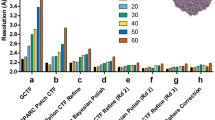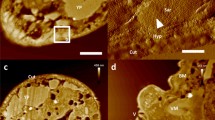Abstract
IN early work on the electron microscopic study of surfaces by the plastic replica process it was tacitly assumed that the upper surface of the replica, that is, the surface remote from that being examined, is substantially flat (fig. 1a). It has been suspected for some time that this is not so, and the matter has been discussed in a recent paper by Deacon et al.1 ; but they have made no direct experimental test. Thus, it might be expected that a normal (unshadowed) replica micrograph would be the result of a superposition of the structure of the surface which had been in contact with the surface to be examined, and that of the upper surface of the replica. If the replica has the shape shown in Fig. 1b, artefacts will be introduced by the contour of the upper surface at the places indicated by dotted lines. A micrograph showing just this effect is reproduced in Fig. 2.
This is a preview of subscription content, access via your institution
Access options
Subscribe to this journal
Receive 51 print issues and online access
$199.00 per year
only $3.90 per issue
Buy this article
- Purchase on Springer Link
- Instant access to full article PDF
Prices may be subject to local taxes which are calculated during checkout
Similar content being viewed by others
References
Deacon, Ellis, Cross and Sennett, J. Appl. Phys., 19, 704 (1948).
Author information
Authors and Affiliations
Rights and permissions
About this article
Cite this article
TROTTER, J. Interpretation of Electron Micrographs Prepared by the Plastic Replica Process. Nature 164, 227–228 (1949). https://doi.org/10.1038/164227a0
Issue Date:
DOI: https://doi.org/10.1038/164227a0
Comments
By submitting a comment you agree to abide by our Terms and Community Guidelines. If you find something abusive or that does not comply with our terms or guidelines please flag it as inappropriate.



